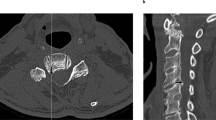Abstract
The object of this study is to demonstrate that angled sagittal magnetic resonance imaging (MRI) enables the precise diagnosis of herniated disc and stenosis in the cervical foramen, which is not available with conventional MRI. Due to both the anatomic features of the cervical foramen and the limitations of conventional MR techniques, it has been difficult to identify disease in the lateral aspects of the spinal canal and foramen using only conventional MRI. Angled sagittal MRI oriented perpendicular to the true course of the foramina facilitates the identification of the lateral disease. A review of 43 patients, who underwent anterior cervical discectomy and interbody fusion, is presented with a herniated disc and/or stenosis in the cervical foramen. They all had undergone conventional MRI and angled sagittal MRI. Fifty levels were surgically explored for evidence of foraminal herniated disc and stenosis. The results of each test were correlated with what was found at each explored surgical level. The sensitivity, specificity, and accuracy of both examinations for making the diagnosis of foraminal herniated disc and stenosis were compared. During the diagnosis of foraminal herniated disc, the sensitivity, specificity, and accuracy of angled sagittal MRI were 96.7, 95.0, and 96.0%, respectively, compared with 56.7, 85.0, and 68.0% for conventional MRI. In making the diagnosis of foraminal stenosis, the sensitivity, specificity, and accuracy of angled sagittal MRI were 96.3, 95.7, and 96.0%, respectively, compared with 40.7, 91.3, and 66.0% for conventional MRI. In the above groups, the difference between the tests for making the diagnosis of both foraminal herniated disc and stenosis was found to be statistically significant in sensitivity and accuracy. Angled sagittal MRI was a more accurate test compared to conventional MRI for making the diagnosis of herniated disc and stenosis in the cervical foramen. It can be utilized for the precise diagnosis of foraminal herniated disc and stenosis difficult or ambiguous in conventional MRI.




Similar content being viewed by others
References
Bischoff RJ, Rodriguez RP, Gupta K, Righi A, Dalton JE, Whitecloud TS (1993) A comparison of computed tomography-myelography, magnetic resonance imaging, and myelography in the diagnosis of herniated nucleus pulposus and spinal stenosis. J Spinal Disord 6:289–295. doi:10.1097/00002517-199306040-00002
Daniels DL, Hyde JS, Kneeland JB, Jesmanowicz A, Froncisz W, Grist TM et al (1986) The cervical nerves and foramina: local coil MR imaging. AJNR Am J Neuroradiol 7:129–133
Edelman RR, Stark DD, Saini S, Ferrucci JT Jr, Dinsmore RE, Ladd W et al (1986) Oblique planes of section in MR imaging. Radiology 159:807–810
Humphreys SC, An HS, Erk JC, Coppes M, Lim TH, Estkowski L (1998) Oblique MRI as a useful adjunct in evaluation of cervical foraminal impingement. J Spinal Disord 11:295–299. doi:10.1097/00002517-199808000-00005
Kelft EV, Vyve M (1994) Diagnostic imaging algorithm for cervical soft disc herniation. J Neurol Neurosurg Psychiatry 57:724–728. doi:10.1136/jnnp.57.6.724
Li KC, Henkelman RM, Poon PY, Rubenstein J (1984) MR imaging of the normal knee. J Comput Assist Tomogr 8:1147–1154
Modic MT, Masaryk TJ, Ross JS, Mulopulos GP, Bundschuh CV, Bohlman H (1987) Cervical radiculopathy: value of oblique MR imaging. Radiology 163:227–231
Murphy WA, Gutierrez FR, Levitt RG, Glazer HS, Lee JK (1985) Oblique views of the heart by magnetic resonance imaging. Radiology 154:225–226
Pech P (1988) Corrective investigation of craniospinal anatomy and pathology with computed tomography, magnetic resonance imaging and cryomicrotomy. Acta Radiol 372(Suppl):127–148
Pech P, Daniels DL, Williams AL, Haughton VM (1985) The cervical neural foramina: correlation of microtomy and CT anatomy. Radiology 155:143–146
Perneczky G, Bock FW, Neuhold A, Stiskal M (1992) Diagnosis of cervical disc disease. MRI versus cervical myelography. Acta Neurochir (Wien) 116:44–48. doi:10.1007/BF01541252
Ross JS, Ruggieri PM, Glicklich M, Obuchowski N, Dillinger J, Masaryk TJ et al (1993) 3D MRI of the cervical spine: Low flip angle FISP vs. Gd-DTPA TurboFLASH in degenerative disk disease. J Comput Assist Tomogr 17:26–33
Schnebel B, Kingston S, Watkins R, Dillin W (1989) Comparison of MRI to contrast CT in the diagnosis of spinal stenosis. Spine 14:332–337
Slone RM, Buck LL, Fitzsimmons JR (1986) Varying gradient angles and offsets to optimize imaging planes in MR. Radiology 158:531–536
Tsurda JS, Norman D, Dillon W, Newton TH, Mills DG (1989) Three-dimensional gradient-recalled MR imaging as a screening tool for the diagnosis of cervical radiculopathy. AJNR Am J Neuroradiol 10:1263–1271
Yenerich DO, Haughton VM (1986) Oblique plane MR imaging of the cervical spine. J Comput Assist Tomogr 10:823–826. doi:10.1097/00004728-198609000-00022
Yousem DM, Atlas SW, Goldberg HI, Grossman RI (1991) Degenerative narrowing of the cervical spine neural foramina: evaluation with high resolution 3DFT gradient-echo MR imaging. AJNR Am J Neuroradiol 12:229–236
Author information
Authors and Affiliations
Corresponding author
Rights and permissions
About this article
Cite this article
Shim, J.H., Park, C.K., Lee, J.H. et al. A comparison of angled sagittal MRI and conventional MRI in the diagnosis of herniated disc and stenosis in the cervical foramen. Eur Spine J 18, 1109–1116 (2009). https://doi.org/10.1007/s00586-009-0932-x
Received:
Revised:
Accepted:
Published:
Issue Date:
DOI: https://doi.org/10.1007/s00586-009-0932-x




